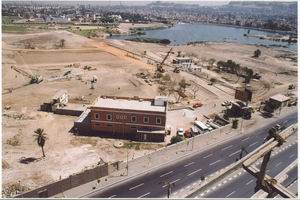 |  | Overview of the NMEC construction site with provisional conservation building, A. Abdel Moneim 2004 |  |
ObjectiveThe planning and conceptualizing of the National Museum of Egyptian Civilization (NMEC) started with the launch of the International Campaign for the Establishment of the Nubia Museum in Aswan and the National Museum of Egyptian Civilization in Cairo in 1982, following a request of the Arab Republic of Egypt in 1978. At this point it was felt that a new museum needed to be built in order to display Egyptian civilization as a whole, embracing all periods of its history from Neolithic times up to today and integrating through a thematic approach a wide variety of materials from national collections. Thereby the museum will serve as an introduction for local and international visitors to all aspects of Egyptian culture. History In 1981 a special working group was formed under the auspices of the Ministry of Culture and assisted by a group of ICOM/UNESCO experts in the fields of Egyptology, Museum Planning, Museology, Architecture and Landscape Architecture. The working group as a liaison between Egyptian authorities and UNESCO experts identified a site for the museum’s construction and developed a concept for the NMEC. The site originally intended for the museum was on the Gezirah island located in the centre of Cairo. This site was abandoned a decade later as it did not provide sufficient space for further development. In the meantime, a national competition was launched in 1983 with the purpose to identify an Egyptian architect - associated with interior designers, exhibit designers, landscape architects and engineers - who would develop architectural, interior and exhibition plans for the NMEC and supervise its construction. The winner of this competition was given the contract to execute the project. Nevertheless, the interior design remained incomplete and its completion was delayed. Given the facts that the original site was judged as not anymore suitable and that the Egyptian Authorities attributed priority to the completion of the Nubia Museum in Aswan, it was only in 1998 that a new site for the museum was identified at El Fostat, an area located on a lake in the south-east of the historic city of Cairo. The initial project was to be adapted to this area. It became clear that adjustments to the original plans (1986) were indispensable in order to integrate the layout of the museum into its new location, to update its exhibition concept and architectural design in line with the rapid development of technology and various aspects of museology, and to respond to increased expectations of local and international visitors. In November 2000, the Executive Committee and the Egyptian authorities started the revision of the NMEC project. Consultancy services were provided by a highly qualified group of international experts from the following fields: archaeology, architecture, landscape architecture, museology, interior design, conservation/restoration, educational services, environmental conditions, museography and documentation. The recommendations that resulted from several expert missions led to a profound review of the NMEC project. This review has been executed by the UNESCO team in collaboration with the Egyptian authorities. Four expert meetings were held in Paris and a workshop was held in Cairo in order to establish and clarify the museum’s vision, concept and policies. The foundation stone ceremony for the NMEC took place in December 2002. Construction started in June 2004, but provisional offices and spaces for storage and laboratories to host and prepare the collection for exhibition have been already set up early. Archaeological discoveries Following archaeological discoveries in the immediate proximity and on the proposed NMEC construction site, archaeological assessment and investigations have become necessary. An UNESCO-expert in archaeology reported in 2001, 2002 and 2003 on the progress made by the archaeological investigations conducted by the Egyptian authorities, assessed the archaeological work necessary and analyzed the possibility to integrate the archaeological findings into the NMEC. These actions are still ongoing as construction of the site has started. Training About 40 initial staff members for the new museum have been appointed by the Egyptian authorities in early 2004. In June 2004, the training programme for the museum staff started with a workshop on "Display of Collections and Physical Care for Collections", which introduced them to general and current issues of museum practices. The next session will be held in early December 2004. Outlook The work carried out by UNESCO and the Egyptian authorities has resulted in a vision and a set of objectives for the museum which will create a civilization museum unique in Egypt being different in character from other museums in existence or planned. The close dialogue between UNESCO and the Egyptian Authorities will continue until the establishment of the NMEC has been completed.
|


